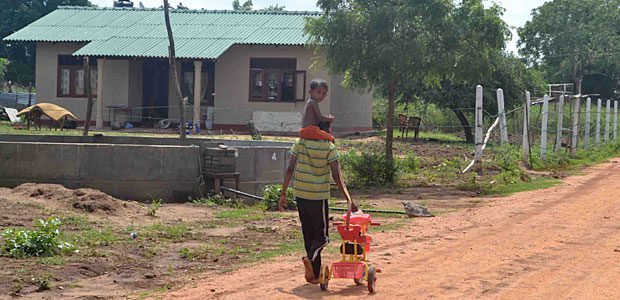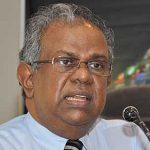Mistaken Motives:
Conflict In Northern Sri Lankan Village Not About Race, But Real Estate
Reports from Kokeliya said that former Tamil Tigers were harassing Sinhalese newcomers. However it turns out the real story was about real estate, not racism.
There have been plenty of rumours and reports about what is going on in the northern village of Kokeliya. The village houses a settlement built for retired Sinhalese soldiers as well as Tamil locals and rumour had it that Tamil gangsters had been threatening the Sinhalese residents, demanding that they leave because the land belonged to the Tamil people.
But upon visiting the area, reporters from The Catamaran heard a different tale altogether.
The individual was trying to force residents off land he believed belonged to him, because he had bought it – albeit illegally
“We don’t focus on the differences between the Tamils and the Sinhalese here and we do not approve of racism,” says Kelaniye Kashyapa, the head monk at the local temple, Sri Bodhi Maluwa. “We prefer to see everyone living together in peace. And in fact,” Kashyapa continued, “the recent clashes were not about racial differences. The fighting started because of confusion created around the sale of real estate.”
Kokeliya is one of the last Sinhalese villages on the way into Sri Lanka’s largely-Tamil north. Thanks to the Sri Lankan civil war, it had been mostly empty for the past few decades. The village used to be home to about 400 families but during fighting the militant organisation, the Liberation Tigers of Tamil Eelan, more commonly known as the Tamil Tigers, forced them out. After the war the land was returned to both Tamil and Sinhalese Sri Lankans and recently the government built what was known as a “reconciliation village”. Retired members of the armed forces moved into the housing there and although there was some conflict about the establishment of the village, locals report that the former members of the army have coexisted happily with their Tamil neighbours.

Nonetheless recent reports suggested that some Tamils had tried to force the Sinhalese newcomers out. Those reports have been reproduced and amplified by individuals who use the story – about Sinhalese being bullied by Tamils – to illustrate their own agendas.
However, it turns out that the conflict here was mostly about possible real estate fraud. According to some of the long-time residents in the village, some locals sold their land during the war. A lot of the sellers were Sinhalese trying to leave the area. A lot of the buyers were Tamils.
During the civil war, both Sinhalese and Tamil villagers in Kokeliya sold their land to an individual named Sinnavan, real name: Parkiyanadan Vishvanadan. This was in clear disregard of the fact that the lands could not actually be sold. The real estate belongs to the Sri Lankan government. If the lease holder leaves the land, its ownership reverts to the government. Yet in this case, the lease holders thought they could sell the land. And now what has happened is that the land, which has changed hands illegally, was given to the people in the reconciliation village.
“A group came and said: These are our lands and you must leave,” explains local woman Sujatha Jayalath; she and her husband, a former member of the Sri Lankan army, had been given a house in the north because that is where they were originally from. “We protested but then they came again and assaulted people. Three locals went to hospital because of their injuries. What we want now is that the government ensures that law and order is maintained and facilitates an environment in which we can live peacefully.”
The individual, Vishvanadan, was trying to force the new residents off land he believed belonged to him, because he had bought it – albeit illegally. Vishvanadan just happens to be Tamil and the new residents here just happen to be Sinhalese. However, that is as far as any racial clash goes; Vishvanadan has now lost both money and the land he thought he owned.

Rather than a racial clash, as it was described by various Sri Lankan media outlets, this fight was more about money and property than anything else. It seems as though in Sri Lanka, these kinds of labels – about religious or racial violence – are often trotted out when the perpetrators cannot resolve their issues.
Because of the threats he made, Vishvanadan was arrested by Vavuniya police on Oct. 2.
“This is not a racial issue, it is an administrative one,” agrees local man, D Bandara, who was also born here. Bandara speaks both Sinhalese and Tamil and is sensitive to the issues between the two groups, he says. “The Tamils and Sinhalese lived here in harmony before. And although many left during the war, they have since returned and there is unity.”
Some of the villagers fear Vishvanadan may be released soon and that he would come back and harass them again.
The village’s head monk Kashyapa believes that the Sri Lankan government needs to solve this problem, because the administrators in the region are the ones who created it.
Nobody had the right to sell the land that had been leased with government permits, M. S. Janaka, the divisional secretary for Vavuniya South explained. “We built houses, roads and water facilities for those who wanted to be resettled,” Janaka says. “Some of them are old and they love the village, although their families have settled elsewhere. There are no racial issues here, just the problems that come with moving to a new place and getting used to it.”





